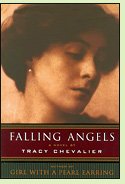Falling Angels
by Tracy Chevalier
Reviewed by Margaret Tomlinson

Falling Angels takes place in London during the time from Queen Victoria's death to King Edward's. Two families with neighboring cemetery plots happen to be visiting the cemetery at the same time on the day after the queen's death, and their five-year-old daughters meet and become friends. The girls are mismatched, Lavinia a romantic whose family allowed her to choose an oversized angel to preside over their family graves, Maude a book-lover. The families are even more mismatched. Maude's father, a banker for whom science takes the place of religion, despises the angel and has insisted on an ostentatious urn for their own plot. Nevertheless, over the years the two girls spend more and more time together, much of it roaming the cemetery, where a gravedigger's son introduces them to a side of life from which both sets of parents have been insulated.
Chevalier's writing is brisk and straightforward; she lets the characters' dialogue and behavior reveal their natures. The story takes its tone from Maude rather than from sentimental, self-dramatizing Lavinia. Victorian mourning customs are the central metaphor in this novel about the crippling effects of dishonesty and silence in family life. Chevalier shows how the elaborately prescribed customs both support human needs - one character remarks that her mourning dress relieves her of a burdensome daily decision about what to wear - but also undermine them by substituting display for genuine emotional expression.
If the central characters are too reserved to sweep readers off their feet, the author's depth of insight into them gives Falling Angels a compelling complexity and genuineness of feeling. (2001, 324 pages)
More about Falling Angels at Powell's Books or Amazon.comOther novels set in cemeteries:
Pure by Andrew Miller (2011), about a young engineer commissioned to close the reeking Paris cemetery Les Innocents and exhume the bodies in 1785, shortly before the French Revolution. More info
Tom-All-Alone’s by Lynn Shepherd (2012; titled The Solitary House in the U.S.), a spin-off from the Dickens novel Bleak House which takes place partly in the horrifying London cemetery Tom-All-Alone's, about an unfairly dismissed policeman who accepts work as a private detective for a sinister lawyer. See review or more info at Powell's Books
The Cavalier of the Apocalypse by Susanne Alleyn (2009), the prequel in a mystery series, about a penniless writer who becomes the chief suspect in a murder investigation after he discovers a corpse in a graveyard; #3 in the Aristide Ravel mystery series. See review or more info at Powell's Books
Nonfiction about mourning customs:
Great Deaths: Grieving, Religion and Nationhood in Victorian and Edwardian Britain by John Wolffe (2001). More info
Widow's Weeds and Weeping Veils: Mourning Rituals in 19th Century America by Bernadette Loeffel-Atkins (2nd ed. 2012). More info
A Magnificent Obsession: Victoria, Albert and the Death that Changed the British Monarchy by Helen Rappaport (2011). More info
Online:
Victorian Mourning Customs from Collier's Cyclopedia published in 1901
Back to 20th Century: Europe Before the Wars
Back to Directory of Book Reviews